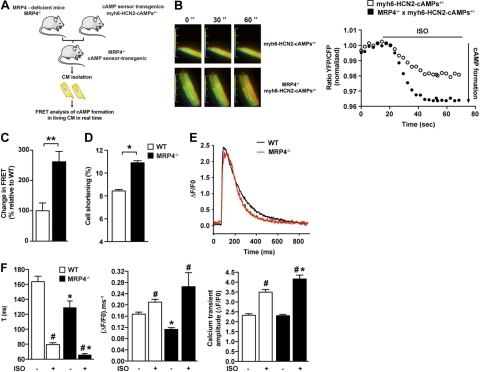Figure 3.
Enhanced cAMP and contractility in 9-mo-old MRP4-deficient mice. A) Design of FRET study. B) Cardiac myocytes isolated from the hearts of 9-mo-old WT and Mrp4−/−mice overexpressing the HCN2-cAMPs FRET sensor were stimulated by 1 nM of iso. Left panel: fluorescent microscopy of freshly isolated adult cardiac myocytes from 9-mo-old WT and Mrp4−/− mice. Ratiometric images reflect changes in cAMP at different times of the recordings. Right panel: measurement of the changes in cAMP-FRET ratios in cardiac myocytes from 9-mo-old WT and Mrp4−/− mice after whole-cell stimulation with iso (1 nM). C) Mean of representative experiments performed in 8–18 cells (3–6 mice) as described in B, **P < 0.001. D) Cell shortening of isolated ventricular myocytes from 9-mo-old WT and Mrp4−/− mice measured in the basal conditions. At least 20 cells/group (3–5 mice). *P < 0.05. E) Representative traces of Ca2+ transient of isolated ventricular myocytes from 9-mo-old WT and Mrp4−/− mice, measured in the basal condition. F) Ca2+ transient of isolated ventricular myocytes from 9-mo-old WT and Mrp4−/− mice, measured in the basal condition or in the presence of iso (100 nM): decay tau (left panel), rate of rise (middle panel), and peak Ca2+ transient (right panel). Experiments were performed in 30–40 cells (3–6 mice). #P < 0.05 vs. −iso; *P < 0.05 Mrp4−/− vs. WT.

